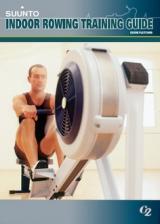Training with the Suunto T6
Jump to info
- About EPOC
- Suunto Training Manager
- Frequently Asked Questions
- Training Effect
- Other Performance Parameters Measured
Getting more out of your training time
In order to get the most out of your training it is important to have a well planned training programme that is periodised and allows you to monitor your improvement regularly. It is also important to monitor your body both during training and during recovery to make sure that you are getting the most out of it, you are not training when ill and you are fully recovered ready to race.
During training it is important that you monitor the intensity that your body is working, not just the splits that you are getting on the indoor rower. This is normally done by monitoring your heart rate during exercise and recovery to make sure that you are exercising in the correct training zone and that you are fully recovered between sessions. Until recently this was the best monitoring method available outside of the laboratory. It is now possible using the Suunto T6 wristop computer to increase your level of monitoring by adding to heart rate six other areas:
- Excess post-exercise oxygen consumption
- Training effect
- Oxygen consumption
- Energy consumption
- Respiratory rate
- Ventilation
The most important of these is the excess post-exercise oxygen consumption (EPOC). EPOC is the amount of extra oxygen your body needs for recovery after exercise. Due to the physiological training load caused by the exercise your body consumes more oxygen after exercise than during rest. The more strenuous the exercise the higher this extra consumption of oxygen (EPOC) is after exercise and the more your body's homeostasis is disturbed.
EPOC is given as a numerical value that is calculated from the duration and intensity of the exercise and other physical and mental factors affecting your bodyincluding stress and fatigue.
EPOC
How Does EPOC Accumulate?
The greater the intensity and the longer the duration of a training session, the higher the EPOC value measured from the session.
EPOC accumulates faster when training intensity increases than when the duration increases. This means that low-intensity training may not necessarily result in a high EPOC value, even if the duration of the training is exceptionally long. With high-intensity training, however, you can reach a high EPOC value even in a short period of time.
In interval training, periods of high heart rate and periods of recovery follow each other. If the recovery periods are short, EPOC can reach a high value, as it will not have time to decrease during a short rest.
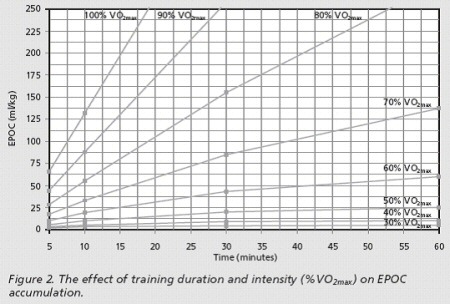
The EPOC value attained from similar exercise can vary from day to day. On a good day, your body can handle the training more efficiently, resulting in a lower EPOC value, but on a bad day, the physiological training load on your body and EPOC may be higher. Many factors affect EPOC during training including your hydration status and the temperature and humidity of the air. If you have performance anxiety or are nervous, this may increase the EPOC value.
How Does EPOC Decrease?
EPOC accumulated during training may begin to decrease during the session, if the training includes sufficiently long rest periods, lower intensity periods or sufficient cool down built into the session. Although EPOC decreases fastest during complete rest, light cool down exercise after hard training will help the total recovery. Cool down increases the circulation, flushing the lactic acid from the muscles faster and speeding up recovery.
All substantial physical activity after the actual training session continues to consume energy delaying the start of full recovery.
EPOC In Different Forms Of Exercise
EPOC is most useful for describing the stress caused to your body by forms of training that especially target the respiratory and cardiovascular system. These include endurance sports such as running, cycling and rowing.
Training involving only small or limited individual muscle groups (for example, weight training) will not necessarily result in an EPOC value as high as training that taxes large muscle groups (for example rowing, running or cross-country skiing). Weight training may feel very strenuous, because local muscle fatigue and lactic acid hinder performance even if your body still has energy for repetitions.
Training Information From The Suunto Training Manager
Recording a training session on your Suunto T6 then downloading it into the Suunto Training Manager software will allow you to produce the following information from your own data.
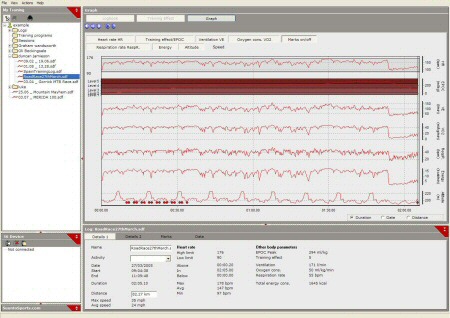
This session is a recording of the physiological data for mountain bikers Duncan Jamieson during a race on 27th March 2005. The top line of data shows his heart rate through the race, the second line his EPOC, the third line his VE (Ventilatory Equivalent), the fourth line is his VO2, the fifth line is the amount of energy he is using during the race and the bottom line shows his altitude.
The data provides much more information about his performance and physiology than can be gained from his heart rate alone. The EPOC shows that he paced his race almost perfectly with his peak coming just a bit too early, and in fact his body was using some energy in the last period of the race to recover as his EPOC is going down. Ideally the EPOC should peak at the very end of the race. In mountain biking the altitude is very important and shows that the course had nine hills, this can then inform us about what we are seeing in the graphs of heart rate, VO2, VE and energy expenditure where there are troughs after each of the peaks where he is cycling downhill and getting some drop in heart rate, VE, VO2 and Energy expenditure.
In a previous graph from the same cyclist his EPOC peaked very early in the race, using this data he was able to perform more consistently in the race shown above.
Data from an interval session done is shown in the graph below.
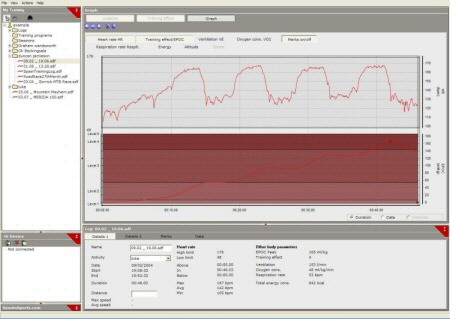
The aim of this interval session was to do four intervals with a rest between each. The rest was designed not to provide recovery from the exertion but to prepare for the next one. The heart rate graph shows each set was conducted at very high intensity and that during the rest he was still getting a heart rate of between 120-130bpm. From the heart rate graph the session looks very well paced, but when it is analysed with the EPOC graph it can be seen that the level of activity between the first and second interval was perfect with his EPOC staying level as desired, in the next two rest periods his EPOC actually decreased so his body was actually recovering slightly between sets. Some sessions will require this but this session is designed not to allow recovery between sets and so shows that he was not working hard enough during the period between the intervals. Armed with this information he will be able to monitor the session better in the future.
Frequently Asked Questions About EPOC
Does heart rate influence EPOC?
Yes. The higher the heart rate in relation to the maximum heart rate, the higher the EPOC.
Can I speed up the decrease of EPOC?
Yes. Complete rest is the fastest way to decrease EPOC. However, after high -intensity training, you should do some light cool down exercises even if this slightly delays the start of full recovery.
Why does EPOC only increase at the start of training, after which it stays nearly the same or even decreases?
In low-intensity training EPOC will not increase noticeably after a certain time. In low-intensity but long-duration training, EPOC will be lower than in high-intensity training. However, continuing training even after reaching the EPOC peak value is worthwhile, because long duration, low-intensity training will develop your base fitness and your body's ability to cope with hard training.
I always run the same distance in the same time. Why is my EPOC value sometimes higher, sometimes lower?
Even if training sessions are identical (same distance, same time), it may be harder on your body on one day, and easier on another. On a good day, the same training will have a lower impact on your body than on a bad day. Factors increasing EPOC include dehydration, stress, sleep deprivation, or the start of illness.
Why is my EPOC sometimes lower after training while tired than after an earlier, completely identical training, I did while well rested?
In certain situations, your body reacts to training by lowering the heart rate and maximum heart rate even if your body is clearly not fully recovered. This may result in a lower-than-usual EPOC. We recommend paying attention to such abnormal behaviour of the EPOC values and ensure that your training program includes a sufficient amount of rest, since continuous training without sufficient recovery leads to overtraining.
Is training more effective the higher the EPOC?
EPOC is an indicator of how hard the exercise session was to your body and how much your physiological homeostasis was disturbed, but the quality of training always depends on your personal goals and situation. It is important to have variety in your training program. In order to develop, you need both high-intensity training where EPOC rises to high levels, and long-duration, low-intensity training and recovery exercise where EPOC remains low.
I did short duration, high-intensity training, after which I was exhausted. Why was my EPOC value low?
In short-duration, maximal or near-maximal exercise, the cause of exhaustion is usually an extreme rise in acidity (lactic acid level) in your body, which makes you unable to continue training. Longer, more sustainable workouts may leave you feeling less exhausted but will cause more total stress, thus resulting in a higher EPOC value.
Training Effect
Each training session you do has some kind of effect on your body. EPOC makes it possible to objectively measure whether the effect of the session was sufficient to improve your fitness level. This is called the Training Effect and can be determined by comparing the EPOC value measured from the training with the athlete's performance level.
The Training Effect is an indicator of how much the training session improved your aerobic fitness, especially the maximum performance of your cardiovascular system and the ability to resist fatigue during endurance training. It does not provide direct information about the effect to, for example, strength or speed attributes.
The Suunto Training Manager software divides the Training Effect into five categories, calculated from your personal background information. The divisions between these categories depend on your fitness level and prior training.
The Training Effect categories are:
- Minor/recovering effect
- Maintaining effect
- Improving effect
- Highly improving effect
- Overreaching
Certain EPOC values correspond with each category. The better your fitness level, the more you have to push your body during training in order to improve your performance and the higher the EPOC values of the Training Effect categories.
Training Effect In Different Kinds Of Training
Long-duration, low-intensity endurance base training
(>1h, <50% VO2max) improves fat metabolism and increases capillary density and heart volume over the long term. This builds a foundation for better maximum performance and harder training in the future. Base endurance training does not usually have an immediate effect on maximum performance, so the Training Effect based on the EPOC value is relatively low.
High-intensity training
(>75% VO2max) directly improves physical properties that increase maximum endurance performance including oxygen transport from lungs to muscles, energy production and utilization, and nerve/muscle cooperation. Improving these properties increases the maximum oxygen intake (VO2max) and resistance to fatigue, thus leading to a better endurance performance. The effect of such training depends on its duration.Depending on individual differences, athletes' objectives and training history the optimal intensity levels of training are different. Experienced athletes must usually train at a higher intensity or for much longer intervals than beginners in order to reach a Training Effect that increases fitness.
Other Performance Parameters
In addition to EPOC and Training Effect, Suunto T6 also measures other data about the functioning of your body. This provides you with more information about what happens in your body during training, and allows you to monitor your development and plan your training in more detail.
Heart Rate
Your heart rate indicates how effectively your cardiovascular system transfers oxygen from your lungs to your muscles. In addition to beats per minute, your heart's stroke volume, i.e., the amount of blood pumped by one beat, correlates directly to efficiency.
Up until now, heart rate has been the only value describing training intensity that could be measured for any exercise. For this reason it is commonly used as a gauge of how strenuous training is, and training is adjusted based on heart rate. Knowing what your heart rate is at any given moment, however, tells you only a small fraction of what effects the training has on your body.
Maximum heart rate is the highest possible heart rate your heart can achieve. It can be estimated based on your age. The latest recommendations suggest using the formula 210 - 0.65 x age when calculating the maximum heart rate. This formula gives a slightly higher maximum heart rate for older people than the earlier formula, 220 - age. Maximum heart rate is, however, very individual, and may differ from the calculated value by as much as 20-30 beats per minute. Determining its accurate value is only possible using a maximum performance test and this should be done if you are to get the most out of the calculations from your Suunto T6.
Resting heart rate is your heart's lowest number of beats per minute when you are at complete rest. Unlike maximum heart rate, resting heart rate and heart volume change as a result of regular training. Endurance athletes who have trained for a long time, for example, have an exceptionally low resting heart rate. Your resting heart rate should be taken when you wake up but before you have done anything else.
The difference between the resting heart rate and the maximum heart rate is called the heart rate reserve (HRR). The intensity of training is often defined as a percentage of the maximum heart rate (%HRmax) or the heart rate reserve (%HRR). The recommended heart rate zones in Suunto Training Manager's sample training sessions are based on percentage of maximum heart rate (%HRmax).
Breathing Parameters
Respiratory rate and ventilation (the amount of air breathed per minute) are called breathing parameters. Changes in the breathing parameter values indicate changes in your body's physiological state.
During exercise, muscles consume more oxygen than at rest, increasing your body's oxygen demand. Your body will respond by increasing ventilation in order to provide enough oxygen for your muscles. This is manifested by an increase in the respiratory rate and the volume of each respiration. Thus, both ventilation and the amount of oxygen provided to your body increase.
The increase in respiratory rate and ventilation is non-linear when exertion increases from rest to maximum intensity; the higher the intensity, the faster the increase. Breathing parameter graphs allow the determination of the aerobic (lactate threshold) and anaerobic (onset of blood lactate accumulation) thresholds which represent the accumulation of lactic acid in your body.
These changes in breathing can be monitored at different levels of exercise as follows: at an easy pace, breathing does not hinder talking, but at a faster pace, talking is intermittent due to being out of breath.
When the exertion level exceeds the anaerobic threshold, respiration rises to such a high rate that talking becomes practically impossible.
Respiratory Rate Scale During Exercise
respirations/min
< 15 rest
< 20 low training intensity
< 35 moderate training intensity
< 50 hard training intensity
> 50 very hard training intensity
Ventilation Scale During Exercise
These values depend on body size, sex and fitness level and include ranges in the table below.
litres/min
< 10-15 rest
< 30-50 low training intensity
< 60-100 moderate training intensity
< 80-150 hard training intensity
> 150 very hard training intensity
Oxygen Consumption
Heart rate indicates the transfer of blood and oxygen to muscles. Oxygen consumption indicates how the muscles use the oxygen for work.
Compared to the breathing variables, oxygen consumption increases in a more linear manner as exertion increases. For this reason, oxygen consumption is, in practice, considered the most reliable variable when exercise intensity level is estimated.
Measurements of breathing variables provide important information about the functioning of your body during training, and, together with the heart rate and oxygen consumption, they allow a thorough analysis of the exercise, revealing things that cannot be deduced based on heart rate alone.
Catergorizing Oxygen Consumption
Oxygen consumption (VO2) is directly dependent on the amount of work your body does. Maximum oxygen uptake (VO2max), on the other hand, is a personal value, affected by your training history and genes.
Maximum oxygen uptake will not, however, directly describe an athlete's performance level. This is because performance is to a large degree determined by how close to the maximum level the athlete is able to maintain his or her performance throughout the entire session, and by how economical the performance is. Economy of performance means how much of the oxygen consumed by the athlete's body actually converts into the performance.
Oxygen Consumption Scale During Exercise
Oxygen consumption of different levels of endurance training as a percentage of the athlete's maximum oxygen uptake:
%VO2max
< 30% - daily physical activities, very light aerobic training
< 50% - light to moderate pace, basic endurance training
< 75% - moderate to hard pace, hard endurance training
> 75% - very hard, VO2max training
Breathing Parameters And Heart Rate Provide Accurate Data On Improvements In Fitness
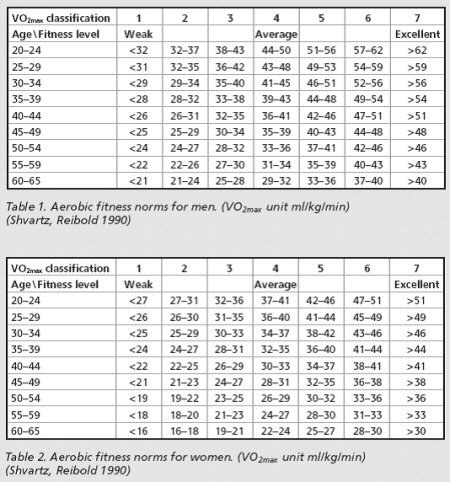
Heart rate can be used to reliably measure improvements in your fitness level. When you perform a familiar standard exercise and improve your time while the heart rate remains the same, it is a sign of improved fitness. Lower heart rate with the same time also indicates improved fitness. As your fitness improves, ventilation and respiratory rate are also reduced during a standard exercise.
Oxygen consumption, however, will remain more or less the same or slightly decrease in a standard exercise, while the maximum level of oxygen consumption will increase along with the fitness.
This table represents your fitness level in comparison to the entire population, based on your VO2max level. The table can also be used for setting your Activity Level in Suunto Training Manager.
Energy Consumption
When muscles perform work, they consume energy. The most important energy sources for muscles are carbohydrates and fats. The energy contained in carbohydrates and fats is released for use in the muscles in a combustion reaction, for which the muscles require oxygen. Thus, the energy consumption of your body is directly proportional to oxygen consumption.
Suunto T6's computer analysis provides two data points of the energy consumption of a given training exercise. The momentary energy consumption kcal/min is a graphical indicator of how the energy consumption varied during training. Total energy consumption indicates how much energy in total was consumed during the exercise. Information about energy consumption offers several possibilities for improving your performance. It allows you to plan the energy replenishment required during long-duration exercises and the pre-training loading. If you aim to lose weight, you can also estimate whether your total consumption is at a sufficient level to reach your goal.
Unlike earlier heart rate based methods for measuring energy consumption, the Suunto T6 measures energy consumption from the entire range of heart rates, from rest to maximum. This enables the measurement of energy consumption from everyday activity and daily tasks as well, even for the entire day.


